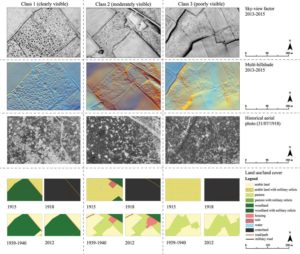
(Danish Journal of Geography, 2018)
Revealing the preservation of First World War shell hole landscapes based on
a landscape change study and LiDAR
The surface scars of the First World War (WWI; 1914-1918) are rapidly disappearing due to modern and fast changing landscapes. Therefore, there is a need to monitor landscape relicts that mark our past. This study examines depressions caused by shelling. These shell holes are still present today and are one of the last remains of the military impact during the 4 years long stalemate on the Western Front. Shell hole landscapes are until now overlooked in landscape research and little attention is given to the causes behind the absence or presence of these shell holes in the present-day micro-topography. This paper aims to identify these causes by using digital interdisciplinary techniques on a landscape scale: Light detection and ranging (LiDAR) giving insights into the presence of the shell holes today, landscape maps indicating the evolution of land use/land cover in the past century and a shell hole density map representing the situation of 1918. Results revealed that the WWI shell hole landscape is still abundantly present today, and where it has disappeared, a direct link was found to land use/land cover transformations and the intensity level of cultivated fields from past to present. To work towards a sustainable management of WWI heritage, these findings are indispensable.
Reference:
Van den Berghe, H., Gheyle, W., Note, N., Stichelbaut, B., Van Meirvenne, M., Bourgeois, J., & Van Eetvelde, V. (2018). Revealing the preservation of First World War shell hole landscapes based on a landscape change study and LiDAR. Geografisk Tidsskrift-Danish Journal of Geography, 1-14.
Link to free e-print (PDF): https://www.tandfonline.com/eprint/En3ucajRYUjUNC5bNNQu/full